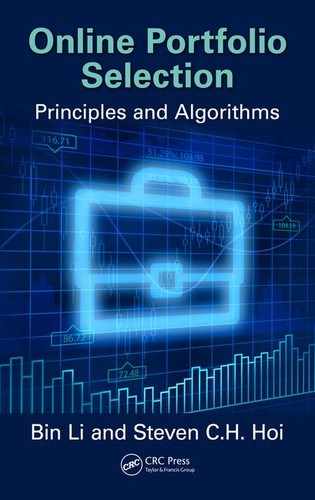
Preface
Introduction
Computational intelligence techniques, including machine learning and data mining,
have significantly reshaped the financial investment community over recent decades.
Examples include high-frequency trading and algorithmic trading. This book studies a
fundamental problem in computational finance, or online portfolio selection (OLPS),
which aims to sequentially determine optimal allocations across a set of assets. This
book investigates this problem by conducting a comprehensive survey on existing
principles and presenting a family of new strategies using machine-learning tech-
niques. A back-test system using historical data has been developed to evaluate the
performance of trading strategies.
Our goal in writing this monograph is to present a self-contained text to a wide
range of audiences, including graduate students in finance, computer science, and
statistics, as well as researchers and engineers who are interested in computational
investment. The readers are encouraged to visit our project website for more updates:
http://olps.stevenhoi.org
Organization
Part I introduces the OLPS problem. Chapter 1 introduces the background and sum-
marizes the contributions of this book. Chapter 2 formally formulates OLPS as a
sequential decision task.
Part II presents some key principles for this task. Chapter 3 summarizes three
benchmarks: the Buy-and-Hold strategy, Best Stock strategy, and Constant Rebal-
anced Portfolios. Chapter 4 presents the principle of Follow the Winner, which moves
weights from winning assets to losing assets. Chapter 5 presents an opposite princi-
ple called Follow the Loser, which moves weights from losers to winners. Chapter 6
demonstrates the principle of Pattern Matching, which exploits similar patterns among
historical markets. Chapter 7 talks about Meta-Learning, which views the strategies
as assets, and thus hyperstrategies.
Part III designs four novel algorithms to solve the OLPS problem. All algo-
rithms apply the state-of-the-art machine-learning techniques to the task. Chapter 8
designs a new strategy named CORrelation-driven Nonparametric (CORN) learn-
ing, which overcomes the limitations of existing pattern matching–based strategies
using Euclidean distance to measure the similarity between two patterns. Chapter 9
develops Passive–Aggressive Mean Reversion (PAMR), which is based on the
first-order passive–aggressive online learning method, and Chapter 10 designs
xv
T&F Cat #K23731 — K23731_C000 — page xv — 10/13/2015 — 16:23
xvi PREFACE
Confidence-Weighted Mean Reversion (CWMR), which is based on the second-order
confidence-weighted online learning method. Chapter 11 assumes multiple-period
mean reversion, or so-called Moving Average Reversion (MAR), and presents a new
OLPS strategy named Online Moving Average Reversion (OLMAR), which exploits
MAR by applying online learning techniques.
Part IV presents empirical studies for benchmarking the performance of the
proposed algorithms. Chapter 12 discusses issues related to the implementation of
a back-test system, which is widely used in the evaluation of trading strategies.
Chapter 13 shows the empirical results on six historical markets. Our empirical results
show that (i) the proposed algorithms generally outperform the state of the art in terms
of the cumulative return and risk-adjusted return and (ii) the proposed algorithms
are highly efficient and scalable for large-scale OLPS in real-world applications.
Chapter 14 discusses various assumptions during the study.
Part V concludes the book and presents some potential future directions.
MATLAB
is a registered trademark of The MathWorks, Inc. For product informa-
tion, please contact:
The MathWorks, Inc.
3 Apple Hill Drive
Natick, MA 01760-2098, USA
Tel: 508-647-7000
Fax: 508-647-7001
E-mail: [email protected]
Web: www.mathworks.com
T&F Cat #K23731 — K23731_C000 — page xvi — 10/13/2015 — 16:23
..................Content has been hidden....................
You can't read the all page of ebook, please click here login for view all page.
